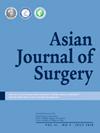双能谱计算机断层扫描对胰腺脂肪含量多参数定量评估的价值
IF 3.8
3区 医学
Q1 SURGERY
引用次数: 0
摘要
双能谱计算机断层扫描(DECT)提供了各种图像数据集,可用于改善脂肪含量的评估。目的探讨DECT在定量评估2型糖尿病(T2DM)患者胰腺脂肪含量中的临床价值。材料与方法回顾性分析123例T2DM患者的DECT资料,其中病例组82例,对照组41例体检结果正常。测定两组CT值、脂(水)浓度及光谱曲线斜率。根据亚太BMI分级标准将T2DM组分为T2DM肥胖亚组(体重指数[BMI]≥25 kg/m2)和T2DM非肥胖亚组(BMI≤25 kg/m2)。比较T2DM非肥胖亚组与对照组、T2DM肥胖亚组与T2DM非肥胖亚组的差异,分析所有T2DM患者BMI与脂(水)浓度、CT值、斜率的相关性。结果T2DM肥胖亚组CT值显著低于对照组,脂(水)浓度及斜率显著高于对照组(P < 0.05)。BMI与脂(水)浓度、斜率呈正相关(r = 0.350、0.372,P < 0.01),与CT值呈负相关(r = - 0.508, P < 0.01)。结论dect是一种无创、有效的胰腺脂肪含量定量评估方法。本文章由计算机程序翻译,如有差异,请以英文原文为准。
Value of dual-energy spectral computed tomography for multiparametric quantitative assessment of pancreatic fat content
Background
Dual Energy spectral computed tomography (DECT) provides a variety of image data sets that can be used to improve the assessment of fat content.
Purpose
To investigate the clinical value of DECT in the quantitative assessment of pancreatic fat content in patients with type 2 diabetes mellitus (T2DM).
Material and methods
The DECT data of 123 patients were retrospectively analyzed, including a case group of 82 patients with T2DM and a control group of 41 patients with normal physical examination findings. The CT value, fat (water) concentration and slope of the spectral curve were measured in both groups. The T2DM group was divided into the T2DM obese subgroup (body mass index [BMI] of ≥25 kg/m2) and T2DM non-obese subgroup (BMI of <25 kg/m2) according to the Asia-Pacific classification criteria for BMI. The differences between the T2DM non-obese subgroup and the control group and between the T2DM obese subgroup and the T2DM non-obese subgroup were compared, and the correlation of the BMI with the fat (water) concentration, CT value, and slope was analyzed in all patients with T2DM.
Results
The CT value was significantly lower and the fat (water) concentration and slope were significantly higher in the T2DM obese subgroup than in the control group (P < 0.05 for all). The BMI was positively correlated with the fat (water) concentration and slope (r = 0.350 and 0.372, respectively; P < 0.01) and negatively correlated with the CT value (r = −0.508, P < 0.01).
Conclusion
DECT is noninvasive and effective for quantitative assessment of the pancreatic fat content.
求助全文
通过发布文献求助,成功后即可免费获取论文全文。
去求助
来源期刊

Asian Journal of Surgery
医学-外科
CiteScore
3.60
自引率
31.40%
发文量
1589
审稿时长
33 days
期刊介绍:
Asian Journal of Surgery, launched in 1978, is the official peer-reviewed open access journal of the Asian Surgical Association, the Taiwan Robotic Surgery Association, and the Taiwan Society of Coloproctology. The Journal is published monthly by Elsevier and is indexed in SCIE, Medline, ScienceDirect, Scopus, Embase, Current Contents, PubMed, Current Abstracts, BioEngineering Abstracts, SIIC Data Bases, CAB Abstracts, and CAB Health.
ASJSUR has a growing reputation as an important medium for the dissemination of cutting-edge developments in surgery and its related disciplines in the Asia-Pacific region and beyond. Studies on state-of-the-art surgical innovations across the entire spectrum of clinical and experimental surgery are particularly welcome.
The journal publishes original articles, review articles, and case reports that are of exceptional and unique importance. The journal publishes original articles, review articles, and case reports that are of exceptional and unique importance.
 求助内容:
求助内容: 应助结果提醒方式:
应助结果提醒方式:


